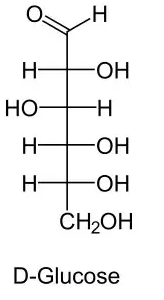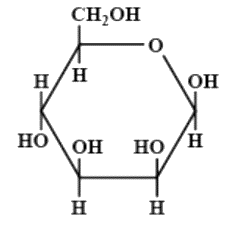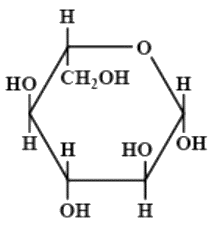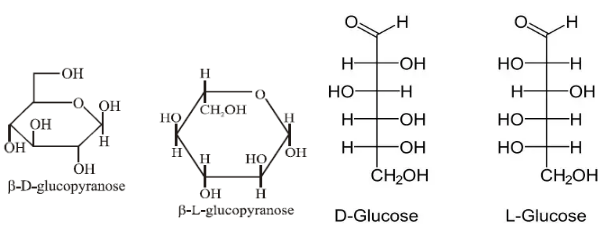
The Fischer presentation of D-glucose is given above:

The correct structures of $ \beta - L $ glucopyranose is/are:
(A)

(B)

(C)

(D)






Answer
540.6k+ views
Hint: To answer this question, you should recall the concept of cyclisation of sugars. We know that the reducing carbohydrates possess anomeric carbon which acts as a chiral centre for the cyclization of the molecules. The cyclization of the carbohydrate molecules forms two different Structural isomers -1) Pyranose 2) furanose.
Complete step by step solution:
Since glucose is an optically active molecule due to chirality, therefore it can show optical isomers which are known as Enantiomers known as $ L\left( - \right) $ glucose and $ D\left( - \right) $ glucose. Here the +ve sign and -ve sign indicates its optical rotation, i.e. dextrorotatory and laevorotatory.
On the other hand, D & L are not related with their optical rotation but they indicate their configurations. The D and L configuration is based on the configuration of a glyceraldehyde molecule which contains one chiral atom. If the $ OH $ group of glyceraldehyde molecules lies towards the right side, it is known as D- configuration otherwise it will be L-configuration.
The resulting structures will be:

Hence, the correct option is option D.
Note:
You should know that if you have seen drawings of sugars before, you might not have noticed the carbonyl. The reason is that carbonyl is usually "masked" as a hemiacetal structure. The hemiacetal structure is generated when a hydroxyl group along the carbon chain reaches back and bonds to the electrophilic carbonyl carbon. We can see from the structure of fructose that the keto group is present on the second carbon. Now two possibilities for cyclization exist: If attacked by the $ {\text{ - C}}{{\text{H}}_{\text{2}}}{\text{OH}} $ on the 6th carbon it will generate pyranose (6-membered) ring and second that, attacked by the $ {\text{ - CH}}\left( {{\text{OH}}} \right){\text{ - }} $ group on the 5th carbon it will result in a furanose. In general, we can conclude that pyranose rings are more stable than furanose rings, because there are more conformational isomeric structures available for pyranose vs. furanose.
Complete step by step solution:
Since glucose is an optically active molecule due to chirality, therefore it can show optical isomers which are known as Enantiomers known as $ L\left( - \right) $ glucose and $ D\left( - \right) $ glucose. Here the +ve sign and -ve sign indicates its optical rotation, i.e. dextrorotatory and laevorotatory.
On the other hand, D & L are not related with their optical rotation but they indicate their configurations. The D and L configuration is based on the configuration of a glyceraldehyde molecule which contains one chiral atom. If the $ OH $ group of glyceraldehyde molecules lies towards the right side, it is known as D- configuration otherwise it will be L-configuration.
The resulting structures will be:

Hence, the correct option is option D.
Note:
You should know that if you have seen drawings of sugars before, you might not have noticed the carbonyl. The reason is that carbonyl is usually "masked" as a hemiacetal structure. The hemiacetal structure is generated when a hydroxyl group along the carbon chain reaches back and bonds to the electrophilic carbonyl carbon. We can see from the structure of fructose that the keto group is present on the second carbon. Now two possibilities for cyclization exist: If attacked by the $ {\text{ - C}}{{\text{H}}_{\text{2}}}{\text{OH}} $ on the 6th carbon it will generate pyranose (6-membered) ring and second that, attacked by the $ {\text{ - CH}}\left( {{\text{OH}}} \right){\text{ - }} $ group on the 5th carbon it will result in a furanose. In general, we can conclude that pyranose rings are more stable than furanose rings, because there are more conformational isomeric structures available for pyranose vs. furanose.
Recently Updated Pages
The number of solutions in x in 02pi for which sqrt class 12 maths CBSE

Write any two methods of preparation of phenol Give class 12 chemistry CBSE

Differentiate between action potential and resting class 12 biology CBSE

Two plane mirrors arranged at right angles to each class 12 physics CBSE

Which of the following molecules is are chiral A I class 12 chemistry CBSE

Name different types of neurons and give one function class 12 biology CBSE

Trending doubts
One Metric ton is equal to kg A 10000 B 1000 C 100 class 11 physics CBSE

Explain zero factorial class 11 maths CBSE

What is 1s 2s 2p 3s 3p class 11 chemistry CBSE

Discuss the various forms of bacteria class 11 biology CBSE

State the laws of reflection of light

An example of chemosynthetic bacteria is A E coli B class 11 biology CBSE




